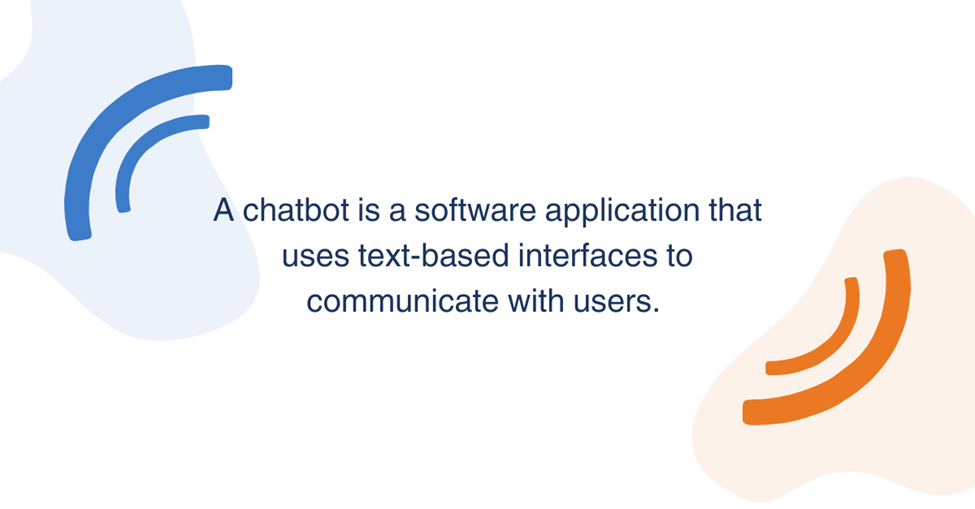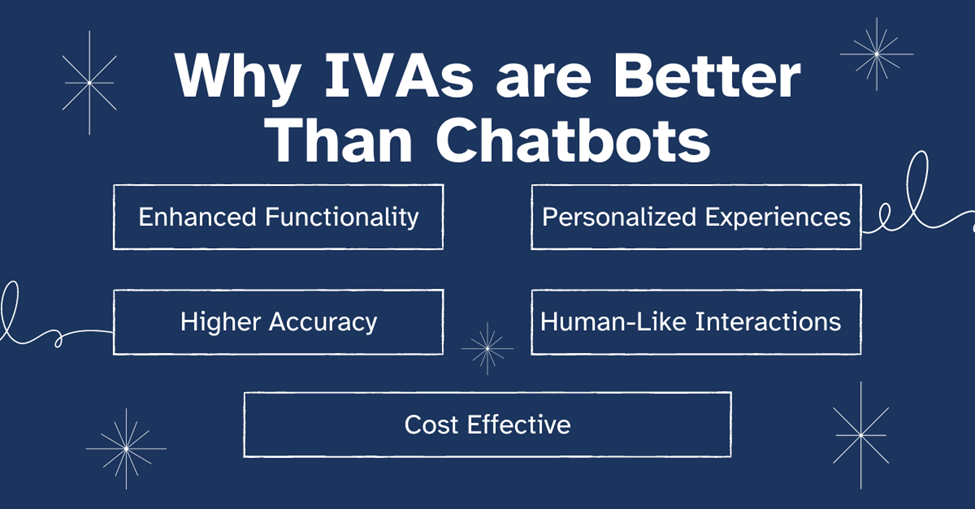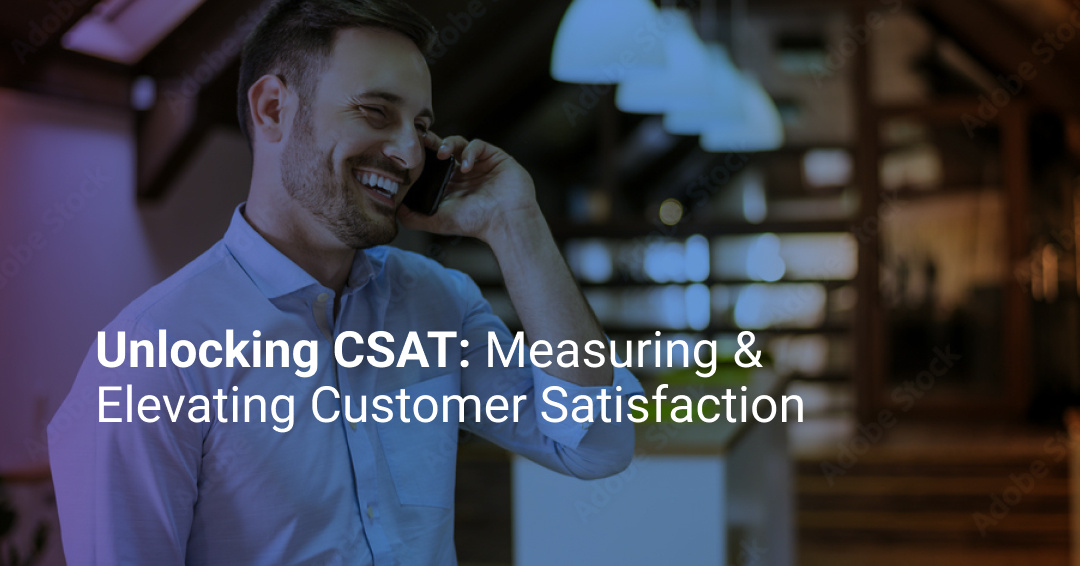12 Call Center Metrics You Should Be Using to Improve CX in 2025
Call center metrics are the most important performance indicators that monitor how effectively your call center is running. This includes anything...

In recent years, there has been a significant increase in the use of customer self-service in the form of chatbots and intelligent virtual agents (IVAs) Although chatbots have been widely used in various industries, they come with several limitations that may hinder their ability to deliver optimal customer service. In this blog, we'll examine the differences between chatbots and IVAs, the benefits of using an IVA over a chatbot, and why companies should consider making the switch to an IVA given its superior features and CX capabilities.
A chatbot is a software application that uses text-based interfaces to communicate with users. Chatbots are designed to simulate human-like conversations and can be used to automate simple tasks or to provide customer service. Chatbots can be integrated into messaging platforms, websites, and mobile applications to provide 24/7 customer support.

Chatbots are widely used in various industries to improve customer service, reduce operational costs, and increase efficiency. Some common chatbot use cases include:
Customer service: Chatbots can provide immediate assistance to customers by answering common questions and directing them to the appropriate resources.
E-commerce: Chatbots can help customers find products, make purchases, and track their orders.
Healthcare: Chatbots can be used to provide patients with medical advice, schedule appointments, and answer common healthcare questions.
Banking and finance: Chatbots can help customers with account inquiries, money transfers, and financial planning.
But while chatbots are commonly used in these ways, they’re not always the best choice for these uses. Chatbots come with several limitations that make it worth considering chatbot alternatives.
While chatbots have become increasingly popular in recent years, they have several limitations that may hinder their ability to deliver optimal customer service. Some chatbot disadvantages include:
Limited functionality: Chatbots are only able to perform a limited set of functions and are not equipped to handle complex queries or customer requests.
Lack of personalization: Chatbots are unable to provide personalized customer experiences as they are programmed to follow a set of predetermined rules.
Inability to handle complex queries: Chatbots are unable to handle complex queries that require human intervention.
Poor communication skills: Chatbots may struggle to understand user queries or provide accurate responses, leading to frustrated customers.
All of these are results of the biggest chatbot disadvantage. They are chat-based only. And that’s usually further limited to web interactions. They can’t send or receive pictures. They can’t talk over the phone. They operate in one way, in one place.
Texting is the most popular way for people to interact today. And when things go wrong, they still prefer to pick up the phone and call someone for help. Chatbots can’t provide that kind of service. When looking for chatbot alternatives, there’s one option that’s usually a better choice.
Intelligent virtual agents (IVAs) use conversational AI, natural language processing (NLP), and machine learning to simulate human-like interactions. IVAs are designed to understand and respond to customer queries in a personalized and natural manner. Here are some of the benefits of using an IVA over a chatbot:
IVAs are equipped to handle complex queries in multiple channels, making them a more versatile solution than chatbots. This results in a much better customer experience and better use of data to inform decisions and improve internal processes. Instead of having to explain themselves multiple times across channels, the omnichannel nature of IVAs allows customers to solve their problems faster across mediums.
IVAs understand user preferences and tailor their responses accordingly. On the contrary, an IVR uses decision trees and predetermined and limited journeys to provide the best possible outcome for any given user. This limitation can significantly impact customer experience, potentially leading to frustrated interactions and reputational damage.
Advanced NLP and machine learning algorithms allow IVAs to understand user queries and provide accurate responses, reducing the risk of frustrated customers. Unlike IVAs, an IVR cannot offer more nuanced and precise responses. IVRs cannot identify a customer's needs in real time and provide a unique answer; instead, they refer to their predetermined and limited solutions.
IVAs are designed to simulate person-to-person communication, providing a more natural and engaging experience for customers. IVRs, on the other hand, are more of an automated machine with multiple options designed to fit some scenarios. If the user's problem does not fit the scenarios, they may be trapped in a loop trying to find a potential way to solve it instead of having an articulate conversation.
IVAs automate a wider range of tasks and make agents more efficient by allowing them to focus on calls that most need their attention. Businesses win by having their best agents concentrate on the most complex problems, and users also benefit by getting solutions faster. Your bottom line improves, reducing operational overheads, the constant issues of handling large customer service departments, and frustrated customers.
Mosaicx IVAs operate in both the phone and text space. They can even initiate conversations with proactive outreach. This creates a more helpful and preferable experience to a chatbot.

Imagine you are a customer who needs to resolve an issue with their mobile phone plan. You have a complex issue that requires a bit of explanation and you need a quick resolution as you have an important call scheduled soon. You visit the mobile company's website and are presented with two options – a chatbot or a voice-based IVA.
You decide to try the chatbot first and start typing out your issue. However, the chatbot is unable to understand the specific details of your problem and keeps providing generic responses that do not address your issue.
Frustrated, you switch to the voice-based IVA option and are greeted with a friendly voice that asks how it can assist you. You explain your issue in detail, and the IVA is able to understand the nuances of your problem and provide you with a personalized solution in a matter of minutes.
The key difference between the chatbot and the voice-based IVA is the ability to understand and respond to complex queries in a natural manner. With the IVA, the customer was able to provide a detailed explanation of their issue, and the IVA was able to understand and provide an accurate solution quickly. In contrast, the chatbot struggled to understand the specifics of the problem and was unable to provide a satisfactory solution. This highlights why a voice-based IVA is better suited for complex customer inquiries compared to a chatbot.
The number of providers for chatbots is quite extensive. Given the rise of AI technology as one of the most predominant innovations during the last couple of decades, there are small players with less experience in the enterprise sector and mass tech providers with years in the market.
We assemble the right combination of AI with human expertise at the enterprise level to ensure all our clients improve their CX while being secure and compliant. For over three decades, we have shaped culture and helped corporations improve their customer experience with the latest technologies.
Our IVA uses artificial intelligence, generative AI, large language processing, and machine learning to ensure thoughtful handling of every interaction. To learn more about our offer and how our IVAs are the best option for handling complex customer inquiries, visit our product site here.
Watson is one of the pioneers in artificial intelligence research and development. In 1997, they became one of the industry's outliers by developing Deep Blue, an AI chess program that beat Garry Kasparov. Ever since, the company has been pushing the industry forward, beating Jeopardy contestants and developing multiple applications across industries, including chatbots.
Google also joined the AI race by developing its own platform for developing chatbots, voice bots, and virtual agents. This platform allows users to design and integrate a conversational user interface, and it has multiple applications and potential use cases. Unlike other options in the market, enterprises looking to adopt Dialogflow require a team of technologists to use the program and adapt it to serve their customers.
This platform allows users to build and integrate conversational AI applications into their business. Just like Dialogflow, enterprises looking to use Amazon Lex to create their own IVA application need a team of technology experts to help them create a seamless and helpful AI interface. Among their primary applications are customer service, intelligent routing, sales, and marketing activities.
Using Microsoft's Copilot Studio and the Azure AI Bot Service, companies can create their own bots to handle user requests. One key differentiating feature is that developing bots using Azure has the comprehensive security and compliance of the entire Microsoft ecosystem built in. While this option does not require a heavy investment in technical expertise (no code), it still requires companies to develop their solutions.
In conclusion, while chatbots have become increasingly popular in recent years, they come with several limitations that may hinder their ability to deliver optimal customer service. On the other hand, intelligent virtual agents (IVAs) use advanced conversational AI and machine learning algorithms to simulate human-like interactions and provide personalized experiences to customers. As demonstrated in the example above, IVAs are better suited for handling complex customer inquiries compared to chatbots. Therefore, companies should consider making the switch to an IVA to improve their customer service and increase efficiency. If you want to learn more about how IVAs can benefit your business, don't hesitate to contact us at Mosaicx and let's explore the possibilities together.

Call center metrics are the most important performance indicators that monitor how effectively your call center is running. This includes anything...

Businesses across industries have changed or evolved over the decades, but one thing that has remained the same is that their growth is pretty much...

Customers have several major expectations from modern businesses, but none is as challenging as them reading your mind to anticipate support you...